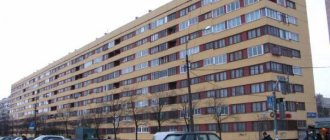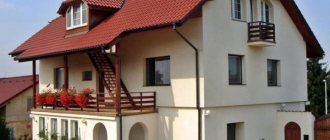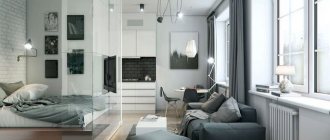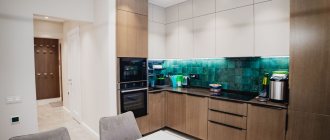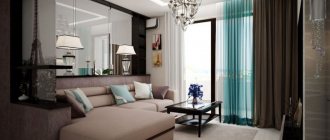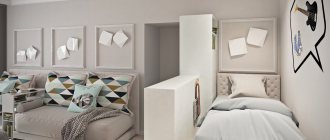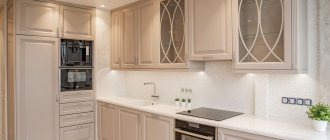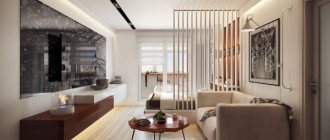The P-111M series has become an improved modification of the 111 series, widespread throughout the country, developed jointly by the 53rd Central Design Institute of the Ministry of Defense of the Russian Federation and TsNIIEP housing.
Construction of the series began in 1996 and continues to this day. The series is distinguished by high performance properties and a variety of planning solutions, including in some versions even two-level apartments.
Photos of houses P-111M
Description
Houses of the P-111M series belong to large-panel buildings. It is one of the modifications of the very successful and very common in the USSR 111th series of panel houses, developed by the design institute TsNIIEP Housing. Distinctive features from the previous P-101 series: variety of apartment layouts, various facade design options (rounded balconies appeared), increased apartment areas. Also, when designing facades, such architectural elements as pediments and decorative belts are used, which is generally atypical for panel housing construction.
The houses of the P-111M series mainly feature 1-3-room apartments.
In 2001, based on the P-111M series, a new standard series of panel-brick houses S-222 was developed, and even later, in 2006, a project of a standard series of panel-brick houses S-220 was developed.
A design feature of the houses of the P-111M series is compliance with international standards for fire resistance and safety. When finishing facades, decorative pediments and belts made of reinforced concrete or lightweight materials are used, which allows increasing the variety of facades. One of the most important advantages of the series is the ability to use various materials for the construction of external walls: these can be hinged three-layer expanded clay concrete panels with effective insulation, expanded clay concrete and gas silicate blocks, or just standard ceramic bricks. Thus, the series allows the construction of a building both in a pure panel design and in a panel-brick design. The latter option allows you to avoid interpanel joints on the facade, the depressurization of which after a significant period of operation is the weak point of all panel houses. However, it requires higher labor costs, and, as a result, leads to higher construction costs.
This series has a fairly significant variety of apartment layouts on the floor (see below and the links). There are even solutions with two-level apartments, which is not at all typical for panel houses.
Source
Ochakovo-Matveevskoe: Real Estate
House series P-111M. Description
The P-111M house series is one of the typical large-panel series of residential buildings.
Built from 1996 to the present. It is found in large numbers in the areas of Khodynskoye Pole, Kuntsevo, Golyanovo, Tekstilshchiki, Lyublino, Pechatniki, Biryulyovo and other areas of Moscow. The P-111M is also common in the Moscow region. Description
Houses of the P-111M series belong to large-panel buildings. It is one of the modifications of the very successful and very common in the USSR 111th series of panel houses, developed by the design institute TsNIIEP Housing. Distinctive features from the previous P-101 series: variety of apartment layouts, various facade design options (rounded balconies appeared), increased apartment areas. Also, when designing facades, such architectural elements as pediments and decorative belts are used, which is generally atypical for panel housing construction.
The houses of the P-111M series mainly feature 1-3-room apartments.
In 2001, based on the P-111M series, a new standard series of panel-brick houses S-222 was developed, and even later, in 2006, a project of a standard series of panel-brick houses S-220 was developed.
A design feature of the houses of the P-111M series is compliance with international standards for fire resistance and safety. When finishing facades, decorative pediments and belts made of reinforced concrete or lightweight materials are used, which allows increasing the variety of facades. One of the most important advantages of the series is the ability to use various materials for the construction of external walls: these can be hinged three-layer expanded clay concrete panels with effective insulation, expanded clay concrete and gas silicate blocks, or just standard ceramic bricks. Thus, the series allows the construction of a building both in a pure panel design and in a panel-brick design. The latter option allows you to avoid interpanel joints on the facade, the depressurization of which after a significant period of operation is the weak point of all panel houses. However, it requires higher labor costs, and, as a result, leads to higher construction costs.
This series has a fairly significant variety of apartment layouts on the floor. There are even solutions with two-level apartments, which is not at all typical for panel houses.
Apartment areas
| Roominess | Total, m² | Residential, m² | Kitchen, m² |
| 1-room apartment | 41-53 | 18-21 | 8-12 |
| 2-room apartment | 56-72 | 31-40 | 8-15 |
| 3-room apartment | 71-96 | 43-55 | 11-13 |
| 4-room apartment | 91-106 | 54-60 | 11-16 |
Detailed Specifications
| Number of sections (entrances) | 1 or more |
| Number of floors | 9-19, the most common option is 17 |
| Ceiling height | 2.60-2.80 |
| Elevators | cargo-passenger 630 kg. and passenger 400 kg. |
| Balconies | In all apartments (glazed by the developer since 2004) |
| Number of apartments per floor | 3, 4, 5, 6 |
| Years of construction | from 1996 to present |
| Demolition prospect | They are not subject to demolition and do not require major repairs. You can find out more about what is being demolished and where here |
| Bathrooms | separate, three- and four-room apartments have an additional toilet. Bathtubs: standard, 170 cm long. |
| Stairs | smoke-free, with access to a common balcony |
| Garbage chute | The garbage disposal is located in a separate mini-vestibule, with a loading valve on each floor |
| Ventilation | exhaust in the kitchen and bathroom |
| Walls and cladding | External walls are three-layer with insulation: an outer layer 8 cm thick, 14 cm made of frost-resistant expanded clay concrete or brick, a middle layer 10 cm, 12 cm, 15 cm thick (thermal insulation boards made of mineral wool and/or polystyrene foam), an inner layer thick for self-supporting panels 7 cm, for load-bearing panels 12-17 cm. The total thickness of the external panels is 30-40 cm. Internal inter-apartment load-bearing walls - reinforced concrete without insulation, 16 cm and 20 cm thick. Partitions - gypsum concrete 8 cm thick. Floors - large-sized reinforced concrete slabs 14 cm and 16 cm thick. Load-bearing walls: internal reinforced concrete, external end Cladding, plastering of external walls: finishing with natural bricks, facing with large-sized tiles or plaster |
| Roof type | Roof type: flat. In some buildings, the balconies of the upper floor have a canopy |
| Advantages | Houses of the P-111M (111M) standard series have increased thermal insulation and comply with the latest requirements of the State Construction Committee of the Russian Federation for energy saving in residential buildings. In new buildings of the series, double-glazed windows in wooden frames are installed. Many buildings have ramps and lifts for the disabled |
| Flaws | quality of installation of external walls in separate buildings |
| Manufacturer | former construction enterprises of the Ministry of Defense |
| Designers | 53rd Central Design Institute of the Ministry of Defense of the Russian Federation, TsNIIEP |
Houses of the P-111M series in the Ochakovo-Matveevsky district
| Natasha Kovshova street | • |
| Bolshaya Ochakovskaya Street |
Layout of a one-room apartment - 3 options for a house of the P-111M series
One room - many possibilities. This statement is true for modern one-room apartments in new buildings. Among the obvious advantages is the increased area. A one-room apartment with an area of 52 square meters is comparable to a two-room apartment built years earlier.
Let's not forget about dressing rooms, which have become a mandatory room in new buildings. Their presence and location are still thought out by developers, and the future owner can only decide: to use the dressing room for its intended purpose - to store clothes there, or to still use these precious square meters for other useful spaces.
Initial layout and house details
The P-111M series are large-panel houses consisting of straight (row and end) sections with loggias, balconies and bay windows. External walls: 3-layer high-strength expanded clay concrete panels with internal insulation. Internal walls: load-bearing – reinforced concrete 160 mm thick, non-load-bearing partitions 80 mm thick.
The houses of the P-111M series mainly have 1, 2, 3-room apartments, but there may be 4-room apartments. The area of the apartments varies depending on the section. Thus, the area of a one-room apartment with the same layout can be from 40 to 52 square meters. All apartments of the P-111M series houses have spacious hallways and utility rooms. Ceiling height is 2.75-2.8 meters.
Prices for approval of redevelopment in a house of the P-111M series
| Redevelopment in a house of the P-111M series | Price for approval | Request for an individual calculation | ||
| Project and technical report | Getting permission | Receipt of the Act, BTI and extract from the Unified State Register | ||
| Redevelopment of an apartment without affecting the load-bearing structures | from 20,000 rub. | from 30,000 rub. | from 60,000 rub. | Get a commercial offer |
| Redevelopment of non-residential premises without affecting load-bearing structures | from 40,000 rub. | from 100,000 rub. | from 100,000 rub. | Get a commercial offer |
| Redevelopment of an apartment with an opening in the load-bearing wall | from 100,000 rub. | from 60,000 rub. | from 60,000 rub. | Get a commercial offer |
| Redevelopment of non-residential premises with an opening in the load-bearing wall | from 120,000 rub. | from 100,000 rub. | from 100,000 rub. | Get a commercial offer |
Layout No. 1: Living room and private sleeping area
This option is suitable for 1-2 people - students or, on the contrary, adults whose children already live separately. The layout allows you to combine a living room and a bedroom with a full-fledged comfortable bed in a one-room apartment.
The proposed zoning requires minimal redevelopment - it is necessary to demolish the internal partition of the dressing room. It is not load-bearing - there will be no problems with coordination. Instead of a storage room, there is space for a double bed. The bed is separated from the corridor by a partition with a built-in wardrobe. The role of a dressing room is performed by a spacious wardrobe near the front door.
Trapezoidal slopes of the walls in the entrance area visually increase the space, but do not deprive it of functionality. However, it is for this reason that in the bathroom the bathtub is replaced by a shower. This decision is individual. It all depends on the personal preferences of the residents.
Layout No. 2: Open-space and home office
This is a studio apartment where the kitchen is combined with a living room area. The reason for this was the spacious bathroom, the area of which was increased due to the corridor. The opening in the wall is a necessary measure, otherwise you won’t be able to get into the kitchen.
An opening is cut into a load-bearing wall - this is a very serious decision that requires prior approval. In some cases this is not possible. For example, it is strictly forbidden to cut openings in load-bearing walls on floors below the middle of the house. If the apartment is located above the middle of the house, there is a chance for permission - this is permitted by law, but an accurate answer can be obtained by contacting authorized organizations. Such a layout of a one-room apartment without approval is prohibited!
In this version, the main change was the movement of the pantry from the right side of the apartment to the left. By removing partitions between the front room and the room, we created an open space, visually increasing the volume. Instead of a pantry, a work area was created for one of the spouses. The entrance to the kitchen is through the living room. The work area has been moved to the wall opposite the balcony to optimize space and allow the dining table to be placed by the window.
Stages of creating the design of a 3-room apartment 111M
New spaces, colors and shapes in the interior are a real “reboot”, giving energy and strength and allowing you to enjoy the simplest everyday activities. The new look of the apartment should remain “fresh” for a long time in the eyes of the Customer, and the desire for decorativeness should not interfere with practicality and convenience.
To create the “right” project, you need to take a number of steps, each of which requires knowledge of many nuances.
- Build a general concept, form and distribute functional areas. In this case, it is necessary to combine the wishes of the Customer and the requirements of building codes.
- Develop the design of individual rooms or zones. When generating ideas for their decorative design, you need to adhere to certain frameworks so that the apartment looks harmonious.
- Select finishing materials, furniture and textiles with which you can most fully express the artistic intent of the author of the project.
- Develop a plan and implement a power supply diagram for lighting and household appliances.
- Prepare an estimate based on the project.
Is it possible to completely surrender to inspiration without leaving the strict framework of fire, sanitary and other requirements? Yes, and only in this case can you turn apartment 111M into a masterpiece of design art. Contacting the A8 design studio is one of the ways to get an excellent result, due to the experience, knowledge and talent of the specialists working in it.
Get 3 interior layout options for free
Leave a request right now and receive a free 3D interior sketch before concluding a contract
Get a 3D sketch
P-111M series
The P-111M series has become an improved modification of the 111 series, widespread throughout the country, developed jointly by the 53rd Central Design Institute of the Ministry of Defense of the Russian Federation and TsNIIEP housing.
Construction of the series began in 1996 and continues to this day. The series is distinguished by high performance properties and a variety of planning solutions, including in some versions even two-level apartments.
Apartments in the P-111M series
Most of the apartments in the series are 1, 2 and 3-room, but there are also 4-room apartments. There are also options for apartments located on 2 levels, which is rare in any panel building.
| Area m² | General | Residential | Kitchen |
| 1-room apartment | 41—54 | 18—21 | 8—12 |
| 2-room apartment | 56—73 | 31—40 | 8—15 |
| 3-room apartment | 71—95 | 43—55 | 11—13 |
| 4-room apartment | 91—109 | 54—60 | 11—16 |
There is a separate bathroom in all apartments, and in three- and four-room apartments an additional toilet can be provided.
Why do you need a design project?
A carefully developed plan allows you to control all stages of the work and gives a clear idea of the required amounts. Thanks to professionally performed calculations, there will be no shortage or excess of materials, and builders will know exactly what is required of them. In addition, the 3D visualization service offered by modern design agencies reduces to zero the risk of unpleasant “surprises” at the final stages of renovation. The customer gets the opportunity to “see” the new interior in all its details before work begins, and, if necessary, make changes to the project.
Apartment layouts P-111M with dimensions
In the apartments of the P-111M series, all apartments have summer rooms - balconies and loggias of various shapes, which, starting from 2004, are glazed during construction.
Examples of floor plans of linear sections P-111M
Layout of corner entrances P-111M
Plan of end and rotary sections of P-111M
In many apartments, the design plan provides dark rooms (closets) and pockets for installing built-in furniture.
How we will work with you
- The Customer's request for work to coordinate the redevelopment of non-residential premises in a residential building in the following form:
- telephone call to company consultants;
- filling out an application on the company website;
- sending an email with initial data on the object (BTI plans, redevelopment sketch, information about the object).
- If the Customer fails to provide any relevant information affecting the quality, cost and timing of work to coordinate the redevelopment of the facility, the company’s specialists will contact the Customer and request the missing data.
- Receipt by the Customer of an individual proposal indicating the scope of work, cost and timing of the service.
- Conclusion of the Agreement, payment by the Customer of an advance payment to the Contractor's bank account.
- Visit of company specialists to the site.
- Carrying out work on the development of design and technical documentation.
- Coordination of design and technical documentation with city authorities with obtaining Permission to carry out repair and construction work.
- Notifying the Customer about the readiness of the documentation, agreeing on the date and time of its transfer.
- Meeting with the Customer, transfer of documentation.
- Familiarization of the Customer with the received documents, signing of the closing documents for this stage of the Agreement (Certificate of Completion), making the payment by the Customer to the Contractor's bank account.
- Carrying out work to obtain a Certificate of Completed Reconstruction.
- Receiving the Certificate of Completed Reconstruction from the Moscow Housing Inspectorate and notifying the Customer of its readiness.
- Familiarization of the Customer with the received documents, signing of the closing documents for this stage of the Agreement (Certificate of Completion), making the payment by the Customer to the Contractor's bank account.
- Carrying out work to make changes to the technical documentation of BTI.
- Receiving BTI floor plans with any redevelopment and notifying the Customer about their readiness.
- Familiarization of the Customer with the received documents, signing of the closing documents for this stage of the Agreement (Certificate of Completion), making the payment by the Customer to the Contractor's bank account.
- Carrying out work to make changes to the Unified State Register.
- Receiving documents from the Unified State Register of Real Estate with the changes made and notifying the Customer about their readiness.
- Familiarization of the Customer with the received documents, signing of closing documents under the Agreement (Certificate of Completion), making the final payment by the Customer to the Contractor's bank account.
Houses P-111M - all the nuances
The series is interesting because in buildings with a load-bearing system assembled from panels, the external (enclosing) walls could be made from a number of materials, supplemented with effective insulation:
That is why P-111M houses in various sources are often called panel-brick or panel-block, despite the fact that the buildings can be completely panel.
Photos of P-111M load-bearing structures
The series provides for the construction of buildings with a height of 5 to 25 floors, with a ceiling height in residential premises of 275-280 cm. The houses are equipped with garbage chutes.
In each entrance, as a rule, one passenger elevator is installed, as well as one or two freight-passenger elevators, which depends on the number of floors.
There are two variants of the series, which are sometimes designated as P-111M and P-111MO, where the first necessarily has a common fire balcony, as required by capital standards.
For this series, the choice of the number of storeys and the material of the external walls remains with the developer, who correlates the cost and labor costs of constructing the building with the urban planning tasks at hand.
Why do you need to coordinate redevelopment in the P-111M house?
- You have a desire to fulfill everything according to the law in order to “sleep peacefully” in the future and be able to carry out any real estate transactions at any time (transaction, purchase and sale, donation, etc.);
- You urgently need to sell real estate, but the documents do not correspond to the actual condition of the property, and you lose money when selling;
- You need to get a loan secured by your real estate, but the bank refuses due to the presence of illegal redevelopment;
- You plan to rent out the property, but the actual layout does not correspond to existing documents;
- You want to be sure that there is no threat to the life of people and building structures when carrying out repair work according to the layout that you have outlined;
- You received a fine and an order requiring approval; redevelopment or the need to return the object to its original state;
- You are receiving complaints from neighbors and you want to remove the complaints;
- You want to be calm and not be afraid of fines and inspections on your premises.
Options for redevelopment of apartments of the P-111M series
Photo of the P-111M series house
Plan of load-bearing walls of a house of the P-111M series
Description of the P-111M series
A series of panel houses widespread in Moscow and the region. Its developers are the 53rd Central Design Institute of the Ministry of Defense of the Russian Federation and TsNIIEP Dwellings. The production of houses of the P-111M series was carried out by construction organizations that were previously directly related to the Ministry of Defense of the Russian Federation. The first buildings appeared in 1996 and are still under construction.
These are buildings with a different number of entrances - from one or more - and different number of storeys - from nine to nineteen floors. The most common are 17-story buildings P-111M. There are from 3 to 6 apartments on the floor. Residents can use freight and passenger elevators.
Apartments in this series are distinguished by a variety of planning solutions. In addition, facades are made differently in houses. For example, there are houses with balconies with rounded edges. When decorating, pediments and decorative belts are used, which is new for panel houses.
Also a feature of the houses of the P-111M series is the presence in some buildings of ramps and lifts for people with disabilities. All houses have excellent thermal insulation.
Most of the apartments in the series are 1-3-room. But there are also 4-room apartments. And also two-level. The apartments may have different ceiling heights - 2.60-2.80 m. Residential premises are equipped with storage rooms, balconies, bay windows, loggias and separate toilets and bathtubs. Larger apartments – three-room and four-room – have an additional toilet.
In one-room apartments, the kitchen area ranges from 8 to 12 square meters. A little more than a kitchen in two-room apartments - 8-15 square meters. m. In three-room apartments, the size of the kitchen space is 11-13 m², and in four-room apartments – 11-16 m².
The thickness of external walls consisting of expanded clay concrete or brick, heat-insulating slabs, self-supporting panels reaches 30-40 cm. Load-bearing walls inside the building without insulation, their thickness is 16-20 cm. 8 cm is the thickness of gypsum concrete partitions. In addition, during the construction of houses in this series, large-sized reinforced concrete slabs with a thickness of 14 cm and 16 cm were used, which serve as interfloor floors.
Source
